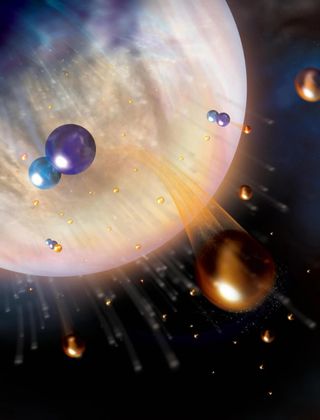Venus, our scorching neighbor, was once a world brimming with water, perhaps even harboring vast oceans. Today, it’s a desolate hellscape, its surface a furnace under a thick atmosphere choked with carbon dioxide. Scientists have long been haunted by this transformation, grappling with the question: what process stole Venus’ water? A new study published in Nature sheds light on this mystery, introducing a previously overlooked molecule as a key suspect: HCO+.

The Vanishing Act: Unveiling the Culprit Behind Venus’ Water Loss
Prior research pointed towards sunlight as the villain. It was believed that sunlight ripped apart water molecules in Venus’ atmosphere, splitting them into hydrogen and oxygen. The lightweight hydrogen then escaped into space, leaving behind a parched planet. This explanation, however, couldn’t account for the final traces of water that stubbornly clung to Venus, hinting at a more nuanced story.
Enter HCO+, a New Player on the Stage
The new study proposes a new culprit – HCO+, a positively charged molecule composed of hydrogen, carbon, and oxygen. In the upper reaches of Venus’ atmosphere, a high-stakes game unfolds. Here, HCO+ interacts with electrons, leading to the formation of carbon monoxide (CO) and the release of hydrogen. Since water is the source of the hydrogen reservoir on Venus, this process effectively acts as a cosmic sponge, soaking up the planet’s water and releasing hydrogen back into space.
Missing Evidence: The Elusive HCO+
There’s a key snag in this theory – scientists haven’t directly observed HCO+ on Venus yet. Previous missions weren’t equipped to detect this specific molecule, although they did measure the ingredients that form HCO+. Finding HCO+ would be a crucial step in solidifying its role as the culprit behind Venus’ water loss.
Future Missions Hold the Key: Unveiling the Secrets of the Upper Atmosphere
Unfortunately, none of the upcoming missions to Venus are specifically designed to detect HCO+. Both NASA’s VERITAS and the European Envision mission, scheduled for 2031 launch, lack the necessary instruments to peer into the drama unfolding in the upper atmosphere. Similarly, NASA’s DAVINCI probe, also launching in 2031, focuses on the lower atmosphere, missing the action where HCO+ is thought to reside.
A Glimmer of Hope: Unveiling the Past
Despite the current lack of direct evidence, computer models in the study suggest HCO+ could explain the missing water on Venus. This finding offers a promising avenue for future exploration, potentially revealing a crucial chapter in Venus’ history. Imagine a time machine that could take us back billions of years, to witness the epoch when Venus’ water began to disappear. The identification of HCO+ brings us a step closer to building that time machine, albeit a scientific one.
The Search Continues: Unveiling the Truth
While the mystery of Venus’ missing water may not be entirely solved, the identification of HCO+ as a suspect is a significant step forward. Future missions specifically designed to detect HCO+ could hold the key to confirming its role and painting a clearer picture of how Venus transformed from a watery world to the desolate landscape we see today. The search continues, and with it, the hope of unraveling the secrets of our enigmatic neighbor. Venus may be shrouded in a thick atmosphere, but with each scientific endeavor, we chip away at the veil, inching closer to understanding the dramatic transformation that this once water-rich world underwent.



















